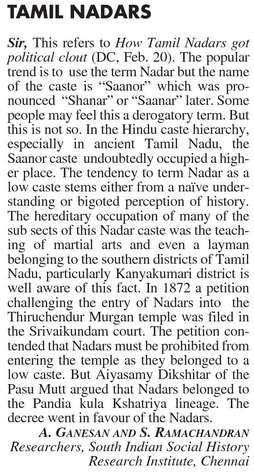
| What we wrote... |
|
|
|
This is with reference to the article "Focus - How Tamil Nadars got political clout" by B. Kolappan in Deccan Chronicle dated 20/Feb/2007. It seems that the author of the article as well as Mr. Poomani whose views the author of the article echoes, lack proper understanding of the social history of Tamils. They are dealing with the Kazhuhumalai and Sivakasi riots which took place in 1895 and 1899 respectively. Nadar's right to temple entry was questioned by Vellalas who occupied administrative posts in the temple oriented social setup in the 19 th century. In the year 1872, concerning the entry of Nadars into the Tiruchendur Murugan temple, Vellalas filed a suit in the Srivaikuntam court (OS number 88 of 1872). The contention of Vellalas was that Nadars must be prohibited from entering the temple as they belonged to a low caste. In that case, Aiyasamy Dikshithar of the Pasur Mutt (Salem district) appeared in the court and testified that the Nadars belonged to the Pandiya kula Kshatriya lineage. The decree went in favor of the Nadars. This fact has been documented in the Ph.D. dissertation by Dr. C. Sarada Devi (retired professor of history, Vanniaperumal College for women, Virudhunagar). Vellalas who had consolidated their position by then in the Hindu social hierarchy took this case as a challenge and decided to push the Nadar community to the fringes with the help of martial communities like Maravas and by using every resource at their disposal. Such efforts of Vellalas culminated in the Kazhuhumalai and Sivakasi riots. The version of Mr. Poomani quoted by Mr. Kolappan that the intervention of Bishop Fr. Caussanel on behalf of the Nadar Christian converts resulted in the acquittal of the Nadars convicted previously by the Magistrate and the acquittal gave psychological boost to the Nadars and Christian missionaries took advantage of the situation to influence Nadars further does not give the correct picture of the situation. Kazhuhumalai Nadar converts were all Catholics. The intervention of Catholic Bishop Fr. Caussanel did not result in any further proselytizing of the Nadars to the Catholic faith. Full fledged effort of the Protestant Missionaries, especially the evangelists of the London Mission to convert the numerically strong Nadar community people with the tacit approval of the British Government, was a different matter and it had no connection with the activities of the Catholic Missionaries. The antagonism of Vellalas towards the Nadars had some deep socio-historical origins and it is reflected in some inscriptions also. For example, the Vellai Nadar inscription of 1453AD at Kallidaikuruchi (Tirunelveli district) and Perumpatru Sevvanthi Naadaan inscription of 1662AD at Vikramasingapuram (Tirunelveli district) are a few examples. The introductory portion to the Annual Report on Epigraphy for the year 1916-17 published by the Archaeological Survey of India, Epigraphy branch contains the remark that these inscriptions show the seeds of the deep rooted animosity still prevalent among the Vellalas and Nadars in Tirunelveli district. The correspondent of a popular newspaper like the DC need not be a Historian or a research scholar in history. We understand it. At the same time, such correspondents must acquaint themselves with fresh historical information being published in magazines as well as research journals. The title of the article "How Tamil Nadars got political clout" itself is misleading. The correct focus must be "How Tamil Nadars regained their socio-political clout". The perseverance of Nadars in those testing times and their ultimate success can be compared to the attainment of supremacy in steel industry by Indians (read Ratan Tata) whose wootz steel (corrupt form of wooks derived from the word 'ukku' or 'ehhu' in Tamil) once dominated the world steel market. One particular point we want to insist is about the popular trend of using the term Nadar for mentioning a particular caste. Nadar is one of the titles or surnames used by this caste. The name of the caste is 'Saanror' which was pronounced as 'Shanar; or 'Saanaar' in later period. Some people may feel it a derogatory term. But, it is not so. There are ample inscriptional evidences to show that the name of the caste has all along been 'Saanror' or 'Saanraar'. In the Hindu caste hierarchy, especially in ancient Tamil Nadu, Saanror caste people undoubtedly occupied a higher stratum. The tendency to term Nadars as a low caste stems either from a naive understanding or bigoted perception of history. The hereditary occupation of many of the sub sects of this Nadar caste was the teaching of martial arts and even a layman belonging to the southern districts of Tamil Nadu, particularly Kanyakumari district is well aware of this fact. Contrary to such historical facts, motivated and biased renderings of the history of Nadars are repeatedly published in popular journals and magazines. We are also relentlessly countering such bashings with literary and inscriptional evidences. Magazines like Indian Express, Junior Vikatan, Kalachuvadu, Puthiya Paarvai and Thinnai.com published our rejoinders. We expect that this rejoinder will be published in your reputed daily. |
| What they published... |

(Courtesy: Deccan Chronicle ePaper, Chennai Edition, 01/Mar/2007) |